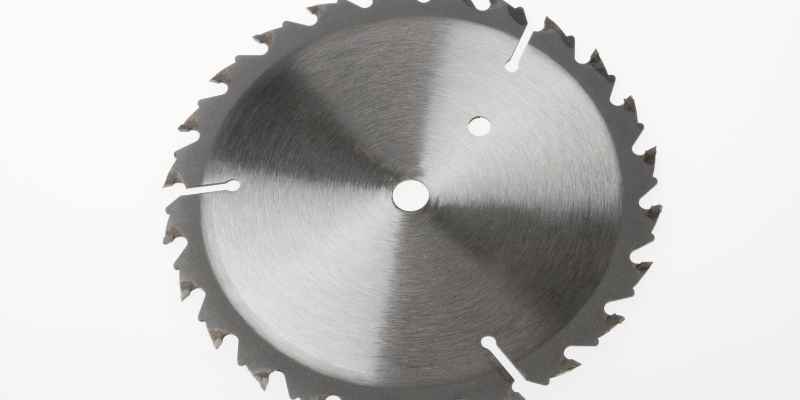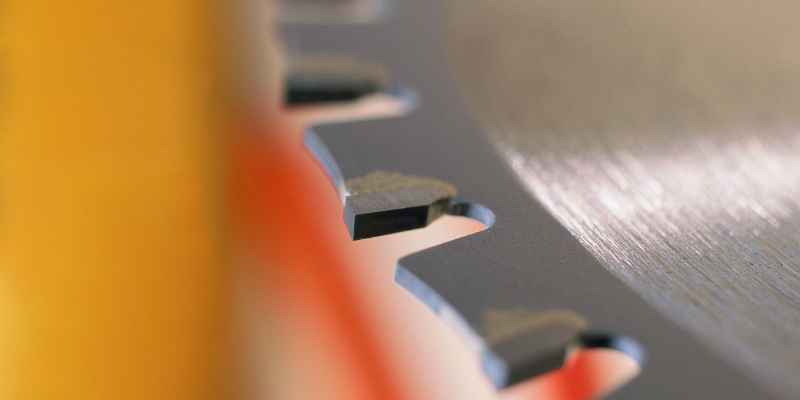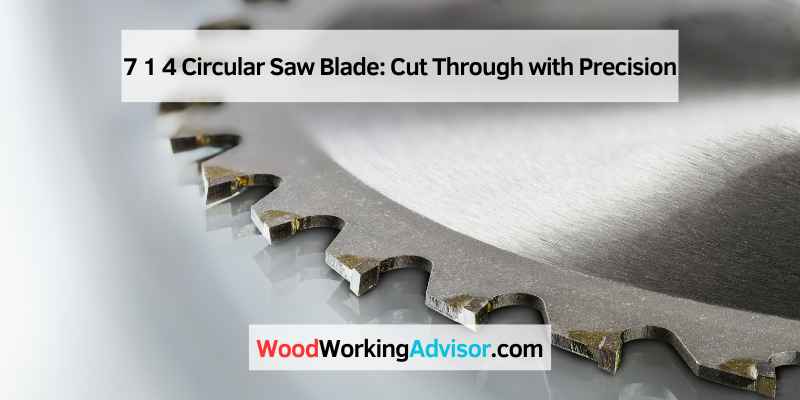The 7 1 4 circular saw blade is ideal for cutting through various materials with precision and efficiency. It offers versatility and durability for different cutting tasks.
A circular saw blade is an essential tool for woodworking and construction projects. With its sharp teeth and durable design, the 7 1 4 circular saw blade is capable of making quick and precise cuts in materials such as wood, metal, and plastic.
Whether you are a DIY enthusiast or a professional contractor, having the right saw blade can make a significant difference in the quality and efficiency of your work. We will explore the features of the 7 1 4 circular saw blade, its uses, and tips for selecting the best one for your needs.
Types Of Circular Saw Blades
Explore various types of circular saw blades for cutting tasks, including the versatile 7 1 4 circular saw blade known for its efficiency and precision. Each type offers unique features to enhance cutting accuracy and performance in woodworking and construction projects.
Circular saw blades come in various types to cater to different cutting needs. Explore the following categories:
Carbide-tipped Blades
Carbide-tipped circular saw blades are durable and suitable for cutting hard materials like metal or hardwood.
High-speed Steel Blades
High-speed steel blades are known for their ability to withstand heat during high-speed cutting applications.
Diamond Blades
Diamond blades are exceptionally tough and are ideal for cutting materials like concrete, tile, and stone.
Each type of circular saw blade has its unique advantages and is designed to deliver precise and efficient cutting performance.

Choosing The Right Blade
When it comes to using a circular saw, one of the most important aspects to consider is choosing the right blade. The blade you choose can significantly impact the quality of your cuts and overall performance. In this article, we will discuss three key factors to consider when selecting a circular saw blade: the material of the blade, the number of teeth, and the size compatibility.
Material Of The Blade
The material of the blade plays a crucial role in determining its cutting performance and durability. Different materials require different types of blades to achieve optimal results. Here are some common blade materials and the materials they are best suited for:
| Blade Material | Best Suited for |
|---|---|
| Carbide-Tipped | Wood, plywood, and melamine |
| High-Speed Steel (HSS) | Aluminum and plastic |
| Abrasive | Masonry, concrete, and metal |
By selecting the right blade material for your specific cutting needs, you can ensure cleaner cuts and prolong the lifespan of your blade.
Number Of Teeth
The number of teeth on a circular saw blade determines the speed and smoothness of the cut. Blades with fewer teeth remove material faster but may result in rougher edges. Conversely, blades with more teeth provide smoother and cleaner cuts but may take longer. The appropriate number of teeth depends on the material you are cutting and the desired finish. Here are some general guidelines to follow:
- For ripping cuts in wood, blades with 24 to 30 teeth are ideal.
- For crosscuts and general-purpose cutting, blades with 40 to 60 teeth provide a balance between speed and smoothness.
- For fine and smooth cuts, especially in plywood or laminate, blades with 80 to 100 teeth are recommended.
By choosing the right number of teeth, you can achieve the desired cutting speed and finish for your specific project.
Size Compatibility
The size compatibility of the blade refers to its diameter and arbor size, which must match the specifications of your circular saw. Most circular saws have a specific blade diameter and arbor size limitation, so it’s crucial to ensure the blade you choose is compatible. Typically, a 7 1/4-inch circular saw blade is the most common size for general-purpose cutting tasks. However, it’s always best to consult the manufacturer’s instructions or check the specifications of your saw before purchasing a new blade.
Choosing the right size blade ensures proper fit, maximum stability, and safe operation of your circular saw.
Maintenance And Safety Tips
A 7 1 4 circular saw blade is an essential tool for any woodworker or construction worker. Proper maintenance and safety precautions are vital to ensure the longevity of the blade and the safety of the user. In this section, we’ll cover important maintenance and safety tips, including blade cleaning, blade sharpening, and safety precautions.
Blade Cleaning
Cleaning the saw blade regularly is crucial to ensure its optimal performance. Here are some simple steps to effectively clean the blade:
- Disconnect the saw from the power source.
- Use a stiff-bristled brush to remove any debris or resin buildup from the blade.
- Apply a commercial blade cleaning solution or a mixture of warm water and mild detergent to dissolve any stubborn buildup.
- Rinse the blade thoroughly with clean water and dry it with a cloth.
Blade Sharpening
Regular sharpening of the saw blade is essential for maintaining its cutting efficiency. Here’s how to sharpen the blade effectively:
- Secure the blade in a vise to prevent movement during the sharpening process.
- Use a flat file or a specialized blade sharpening tool to sharpen each tooth of the blade at the same angle.
- Remove any burrs or rough edges with a honing stone.
- Ensure the blade is properly balanced after sharpening to prevent vibration during operation.
Safety Precautions
When using a circular saw blade, it’s essential to prioritize safety. Here are some crucial safety precautions to keep in mind:
- Always wear appropriate safety gear, including goggles, ear protection, and gloves.
- Ensure the saw is turned off and unplugged before performing any maintenance or blade-related tasks.
- Inspect the blade for any signs of damage or wear before each use.
- Follow the manufacturer’s guidelines for proper blade installation and usage.
- Never force the blade through the material and avoid cutting wet or damp wood.
Techniques For Precision Cutting
When using a 7 1 4 circular saw blade, achieving precise cuts is essential for professional results. By employing the following techniques, you can ensure accurate and clean cuts for your woodworking projects.
Setting The Depth
To achieve precise cuts, setting the depth of the circular saw blade is crucial. Ensure that the blade’s depth is just slightly deeper than the material you are cutting to prevent tear-out and splintering.
Using A Guide Fence
A guide fence serves as a useful accessory for achieving precision cuts with a circular saw. Secure the guide fence parallel to the cut line, allowing it to guide the saw for straight and accurate cuts.
Angle Adjustment
For angled cuts, the angle adjustment feature of the circular saw comes into play. Properly adjusting the angle ensures that you achieve the desired bevel or miter cut with accuracy.

Common Circular Saw Blade Issues
Blade Dulling
One of the most common issues faced with circular saw blades is blade dulling. Over time, the sharpness of the blade can deteriorate due to continuous use, resulting in poor cutting performance. When the blade becomes dull, it requires more effort to make clean cuts, which can be frustrating and time-consuming.
There are several factors that contribute to blade dulling. Firstly, cutting certain materials like hardwood or metal can wear down the blade edges faster. Additionally, applying excessive pressure or using the wrong saw speed can also accelerate blade dulling.
Kickback Prevention
Kickback is a dangerous situation that can occur when the circular saw blade binds or stalls during a cut, causing the saw to jerk back towards the user. It can result in serious injuries and accidents if not addressed appropriately.
To prevent kickback, it is vital to maintain a firm grip on the saw and ensure proper cutting techniques are followed. Using a circular saw blade with anti-kickback features can also minimize the risk of kickback incidents. These blades typically have a design that reduces the chance of the saw getting caught or stuck in the material being cut.
Overall, being aware of these common circular saw blade issues such as blade dulling and kickback prevention can help you optimize your cutting experience and extend the lifespan of your circular saw blades. Remember to use appropriate safety measures and inspect your blades regularly to ensure they are in good condition.
Advanced Cutting Methods
Discover Advanced Cutting Methods with the 7 1 4 Circular Saw Blade
Bevel Cutting
Bevel cutting with the 7 1 4 Circular Saw Blade allows for angled cuts up to 45 degrees.
- Perfect for creating chamfered edges on various materials
- Provides precise bevel cuts for detailed woodworking projects
Dado Cutting
With the 7 1 4 Circular Saw Blade, dado cutting becomes efficient and accurate.
- Enables quick creation of dado joints for strong connections
- Perfect for slotting shelves and creating custom furniture pieces
Frequently Asked Questions Of 7 1 4 Circular Saw Blade
What Is A 714 Circular Saw Blade Used For?
A 714 circular saw blade is designed for cutting wood, plastic, and metal. Its versatile design makes it suitable for various DIY and professional projects such as framing, trim work, and decking.
How To Choose The Right 714 Circular Saw Blade?
When choosing a 714 circular saw blade, consider the type of material you’ll be cutting, the number of teeth on the blade, and the blade’s diameter. For wood cutting, select a blade with more teeth, while fewer teeth are ideal for metal cutting.
What Are The Key Features Of A High-quality 714 Circular Saw Blade?
A high-quality 714 circular saw blade should have durable carbide tips for long-lasting sharpness, anti-vibration slots for smooth cuts, and a corrosion-resistant coating to withstand tough working conditions. Look for a blade with precise grind angles for clean and accurate cuts.
Conclusion
To sum up, the 7 1 4 circular saw blade is a versatile and efficient tool that should be a part of any woodworker’s arsenal. With its sharp teeth and durable design, this blade delivers precise cuts and enhances productivity.
Whether you’re working on DIY projects or professional woodworking tasks, this circular saw blade will ensure smooth and accurate results. Upgrade your saw and experience the difference with the 7 1 4 circular saw blade.

